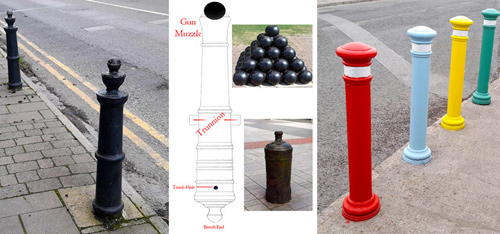Many of the traffic bollards or road posts on view here on the streets of Thurles, Co. Tipperary; same recently fashioned to represent unserviceable cannon guns, first used as early as the 17th century, (“Iron Gunns Broken sett into ye ground”).
A lot of these redundant old iron cannon guns were sold for scrap by the Royal Navy or by civilian ships such as whalers and merchantmen, before being recycled to use as bollards by Civil authorities.
While for the most part these scrapped canon guns were used in England and France, examples can also be found here in Ireland e.g. Cork City.
Businesses also bought them, when they needed road posts, as scrap cannons were cheaper than purpose-made stone bollards. These road stops were created by burying one end or other into the ground; the muzzle end uppermost closed by a cannon ball to keep out water, while the breech end of these redundant iron cannon was used pointing uppermost, to tie-up/moor ships alongside quays and river banks.

The last few nights, here in Thurles, Co. Tipperary, brought the first of this Autumn’s expected and forecasted ground frost; which brings me to supposedly explain the commonly used phrase, “It is cold enough to freeze the balls of a brass monkey”.
Supposedly, on the decks of early sail going war-ships, in the 16th to 18th centuries, it was the practice to put iron cannon balls on a dimpled brass plate called a ‘monkey’. Here they could be piled into a 5 row high pyramid shape, ready for use. However, due to very cold temperatures this dimpled brass plate would contract sufficiently to cause the iron cannon balls to roll out of this brass holder.
While this is the commonly used explanation for this phrase, physics does not stand up to accurate scrutiny. Such cannon shot was never left exposed to the elements, where it could rust. Rust could lead to the ball not flying true to target or to become jammed in the muzzle or trunnion area, thus causing the gun to explode.
Also, because of rough boat rocking seas, it would have been highly unlikely, that such cannonball storage practises would ever have been entertained in real life, on board any sea going warship.

Leave a Reply